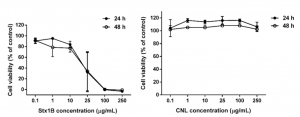In cancer, aberrant glycans are expressed on the membrane. The structures and densities, of course, vary depending on the cancer types, but in general, it would be characterized by the expression of multi-branched N-glycans, the increase of O-glycans, the truncation of O-glycans, and the changes in terminal modification (i.e., sialic acid, fucose).
A group from Univ. of Ljubljana has proposed a method of targeting to cancer cells by using geneicaly modified Lactoccus lactis (a type of Gram-positive bacteria) to express lectins on the membrane specific to the aberrant glycans of cancer cells.
https://www.mdpi.com/2076-2607/9/2/223/htm
Specifically, they focused on two types of lectins. One is B subunit of Shiga holotoxin (Stx1B) and the other is Critocybe Nebularis lectin (CNL).
The glycan binding specificity of these lectins is as follows,
Stx1B = Gb3,
CNL = LacdiNAc.
Since these lectin genomes have been published, they have been incorporated into plasmids, and lectococcus lactis were modified using the plasmids to express those lectins on the cell membrane.
Stx1B itself has cytotoxicity, so it can effectively adhere to cancer cells and kill them as shown below.
Since CNL has not cytotoxicity, targeting to cancer cells is possible, but it is not cytotoxic at all.
Finally, they are proposing a method of using such bacteria modified to express lectins suitable for targeting to cancer cells carrying therapeutic agents.

